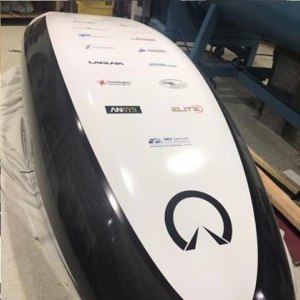UCI’s hyperloop team looks to propel transportation technology forward
While other students are out partying on a Friday night, a team of UC Irvine undergrads is installing new control systems and fine tuning software for their hyperloop pod. Their prototype is a step toward realizing Elon Musk’s vision of whisking passengers and cargo from Los Angeles to San Francisco in 30 minutes. The team of 54, known as HyperXite, has entered the hyperloop transportation arms race and recently placed fifth in a heated international design competition.
The HyperXite laboratory looks like the stereotypical engineering factory with cables and chipsets scattered all over the floor. On one side of the room is a half-scale carbon fiber pod designed to carry 28 people. On the other side of the room is the mechanical base that attaches to the bottom of their designed pod. The pod is covered with stickers from the team’s sponsors, making it clear that HyperXite has a lot of support.
The pod’s function is fairly simple. A pusher applies 1900 pounds of force to accelerate the pod along a rail. A set of air skis levitates the pod in the vacuum hyperloop tube. Magnetic brakes that utilize air springs to decelerate slow the pod from a speed of 760 miles per hour. Two compressed air canisters are used to power almost the entire system. The intuitive design might make you wonder why the pod was not built decades ago.
HyperXite’s newly improved pod is expected to be completed and fully functional by August 11, in time for the second SpaceX Hyperloop competition on August 25. At the competition, the team’s pod will be expected to accelerate, cruise, and brake on the 1-mile hyperloop track in Hawthorne, California. With a total of 23 student teams participating, competition will be fierce.
 HyperXite’s Pod
HyperXite’s Pod
Project manager Arwa Tizani says there is a good chance HyperXite will come in first at the competition.“We already built our pod and got the chance to test it at SpaceX, so we have an idea of what’s coming,” he said.
Regardless of the outcome, what is more important to Arwa than winning the competition is the gateway to the transportation future that the team provides: “We are actually making a difference, and getting tangible results. Everyone always talks about wondering what the future will look like, so I knew I wanted to be behind the curtain, making it happen. It’s crazy to think that our team is actually building something that someday people will look at and say, “How could we have lived without it?’”
The technology to construct a hyperloop already exists and, as the team’s control lead Andrew Tec reminds us, it couldn’t be too difficult to build “if a bunch of university students could do it.”
Arwa expects the hyperloop “to be available for public use in the next 10 years.” However, some members of Arwa’s team, such as braking lead Brian O’Sullivan, remain skeptical. Though Hyperloop is “the ideal solution to the transportation issues in California,” Brian figures state “government regulations, permits, and getting it approved” will slow development.
But hyperloop is a much better transportation than the state-funded alternative: California High-Speed Rail (HSR). The hyperloop system is estimated to cost $6 billion while HSR is expected to cost a whopping $64 billion. Instead of allowing the private sector to implement hyperloop for inter-city travel, Sacramento is wasting taxpayer money on a slower and much more expensive option.
Nicholas is a policy research intern at the California Policy Center. Nicholas spent the past two years studying economics throughout the United States on exchange from the University of Queensland, Australia. Prior to joining the Koch Fellowing Program, Nicholas worked at the Professional Research Institute for Management and Economics in Cambodia and at the Buckeye Institute in Ohio.
